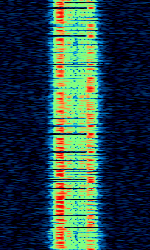Russian Intelligence 200bd 500Hz FSK (F01)
This is a digital FSKFrequency-Shift Keying mode used by the "Russian 6" numbers station operator which is likely a major Russian intelligence agency. It is also known as F01 and it is technically similar to RTTY. The message contents are encrypted but header data such as serial numbers can be identified.
Frequency shift is 500 HzHertz (Hz), unit of frequency, defined as one cycle per second (1 Hz). and symbol rate is 200 bdBaud (unit symbol Bd) is the unit for symbol rate or modulation rate in symbols per second.. F01 transmissions happen on a fixed schedule and sometimes sporadically. Typical F01 schedules have 2 or 3 transmissions 10 minutes apart and each 1 to 3 MHzMegaHertz (MHz) 10^6 Hz lower or higher in frequency.
Samples[edit]
Full transmission:
Note: You may encounter samples with different pitch depending on the USBUpper Side Band Modulation (Radio, referring to reception and modulation mode)Universal Serial Bus (Computer, referring to USB Ports and cables) tuning frequency.
Frequencies[edit]
Known frequency range of F01 is at least 4 MHzMegaHertz (MHz) 10^6 Hz to 23 MHzMegaHertz (MHz) 10^6 Hz.
Decoding Software[edit]
- Rivet supports decoding of this mode, but cannot decrypt it.
Using an RTTY decoder for F01 may produce some kind of decoded output, provided that it supports 500 HzHertz (Hz), unit of frequency, defined as one cycle per second (1 Hz). shift and 200 bdBaud (unit symbol Bd) is the unit for symbol rate or modulation rate in symbols per second. symbol rate. However, RTTYRadio TeleTYpe decoders are likely unable to interpret the output as numbers which is the way this mode is usually decoded. RTTYRadio TeleTYpe decoders cannot decrypt this mode either.
Video Examples[edit]
- Signal Phantom: Russian digital numbers station F01
- driverfilmsshortwave: F01 Number Station Picked up On WebSDR 7723Khz 19:00UTC 7/10/15
- MiloSW: F01 Numbers Station on 17469kHz 00:00 UTC 3/13/18

